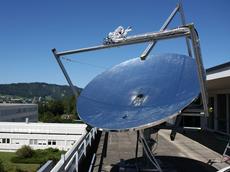The power of 2000 suns
Scientists have announced a collaborative project to develop a cost-effective photovoltaic system capable of concentrating the incoming solar radiation to the power flux of 2000 suns and convert it to useful energy, both electrical and thermal energy, with an efficiency of 80 percent.

Together with IBM Research, the Interstate University of Applied Sciences Buchs and the supplier of solar power technology, Airlight Energy, scientists of ETH Zurich are developing a new photovoltaic system. The so-called “High Concentration Photovoltaic Thermal” (HCPVT) system will deliver electricity, fresh water and cool air in remote locations and shall be capable of concentrating, on average, to the power of 2000 suns, with an efficiency that can collect 80 percent of the incoming radiation and convert it to useful energy.
Replace expensive material
The
scientists plan to use a large parabolic dish, comprised of a multitude of
mirror facets, to focus the sunrays onto a triple-junction photovoltaic cell mounted
on a microchannel cooled module. The system should be able to directly convert
more than 30 percent of collected solar radiation into electricity and further allow
for the efficient recovery of waste heat above 50 percent.
“Reaching high conversion efficiency with a low-cost system is the main challenge in this project”, says Aldo Steinfeld, professor for Renewable Energy Carriers at ETH Zurich and head of the Solar Technology Laboratory at PSI. His group at ETH’s Institute of Energy Technology will develop the optical design of the solar concentrator sub-system. This includes the sun-tracking parabolic concentrator and the matching secondary non-imaging reflector. “Advanced ray-tracing numerical techniques will be applied to optimize the optical configuration and reach uniform solar fluxes exceeding 2000 suns at the photovoltaic cell”, explains Aldo Steinfeld.
Using Aquasar technology
Once aligned, the sun’s rays reflect off the mirror onto several microchannel-liquid cooled receivers with triple junction photovoltaic chips – each 1x1 centimeter chip can convert 200-250 watts, pretty constant, over a typical eight hour day in a sunny region. The whole receiver combines more than hundred chips and provides 25 kW electrical power. The photovoltaic chips are mounted on microstructured substrates that pipe liquid coolants within a few tens of micrometers from the chip to absorb the heat and draw it away 10 times more effectively than with passive air cooling. Using hot water cooling Aquasar technology as already implemented for Datacenters.
The estimated cost per aperture area is below $250 per square meter, which is three times lower than comparable systems. The levelized cost of energy will be less than 10 cents per kilowatt-hour (KWh).
Prototype is being tested
With the HCPVT packaging approach scientists can both eliminate the overheating problems of solar chips while also repurposing the energy for thermal water desalination and cool air. The 90 degree Celsius water will pass through a porous membrane distillation system where it is then vaporized and desalinated. Such a system could provide 20 liters of drinkable water per square meter of receiver area per day. “The integration of several novel components, e.g. the faceted concentrator, the secondary optics, and the microchannel heat exchanger, makes the HCPVT system unique”, says Aldo Steinfeld.
Scientists envision the HCPVT system providing sustainable energy and fresh water to locations around the world. A prototype of the HCPVT is currently being tested at the IBM Research lab in Zurich. The project is funded by the Swiss Commission for Technology and Innovation (CTI) with 2.25 million Swiss Francs.
- 03.07.13: Photovoltaik: Abwärme nutzen
- 29.04.13: Photovoltaik: The design of optics
- 24.04.13: Photovoltaik: Good News








READER COMMENTS